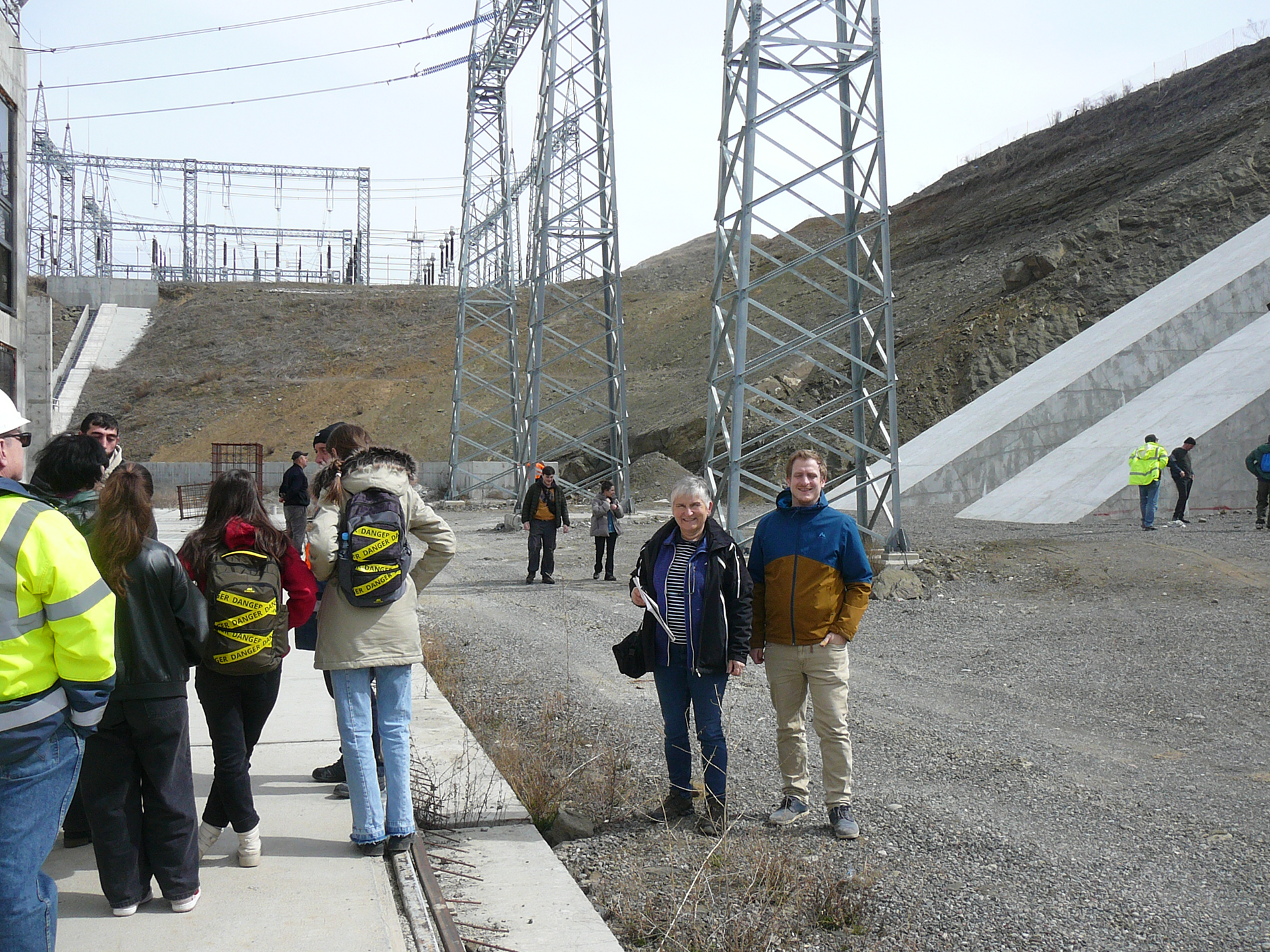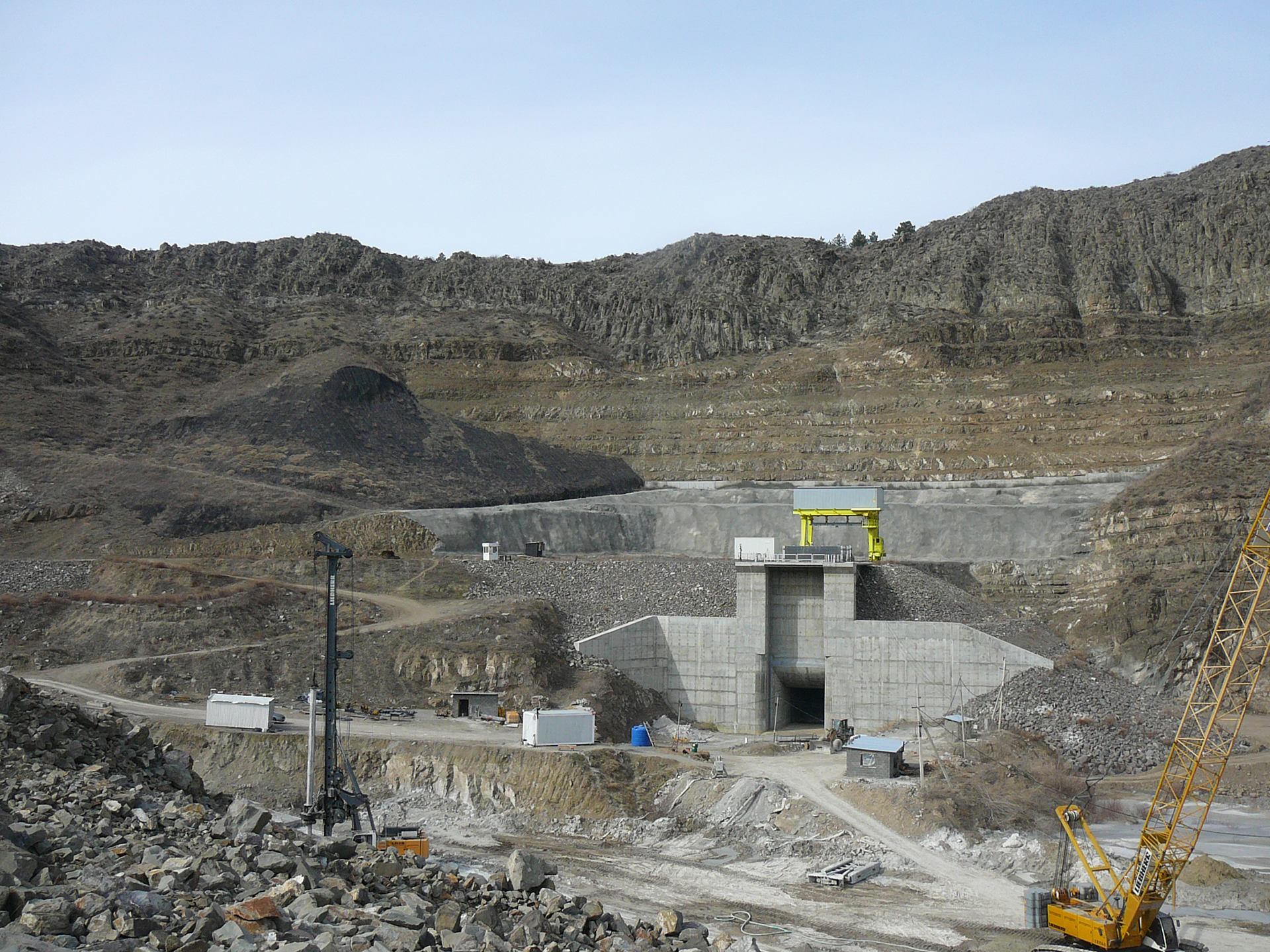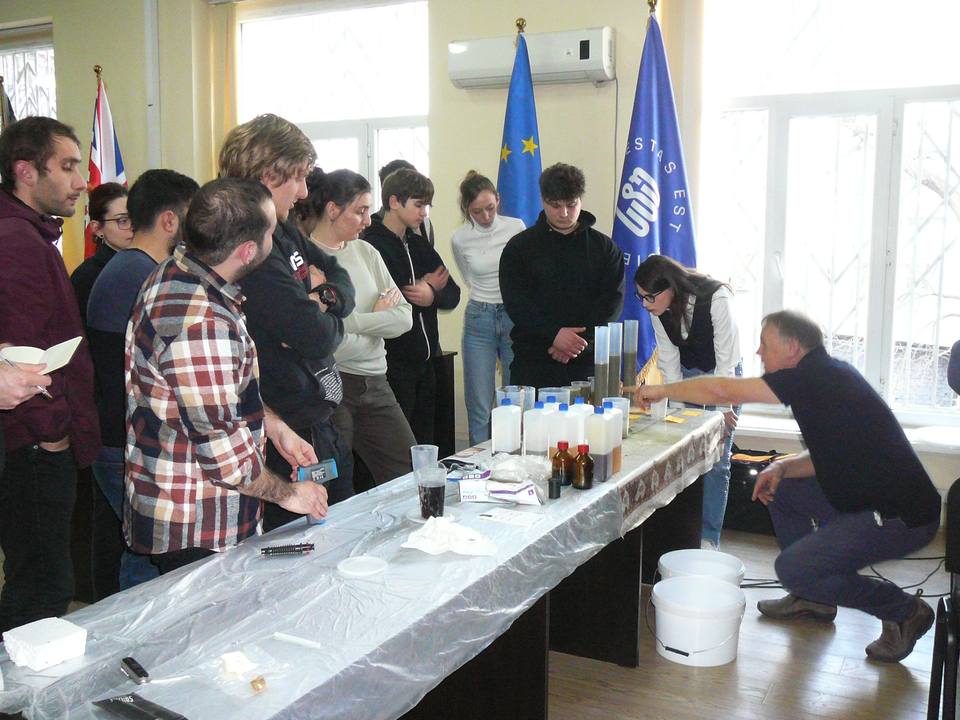Tuesday, September 17, 2024
The day started with Thomas, Roman, Hagen, and Birgit preparing the “mobile core analysis lab” at Hotel Enguri. They made sure everything was ready for the practical sessions.
In the evening, students from Tbilisi State University (TSU) and Georgian Technical University (GTU) arrived. After dinner, the first activities of the course began. Dr. Müller welcomed everyone, and then the students gave short presentations about their current work and their interest. The presentations were impressive and very interesting, even for the German lecturers. It was a great start to the course, with lots of exciting ideas shared.
Following the student presentations, Birgit Müller introduced the main theme of the course, detailing what the group would be working on over the next five days. She outlined the practical exercises and theoretical discussions related to geomechanics and core analysis, providing a clear roadmap for the course. In addition to practical work, the students also participated in lectures held by professors, which provided deeper insights into various aspects of geomechanics and core analysis.
Additionally, Birgit discussed the UN Sustainable Development Goals (SDGs) and how they relate to geosciences. For example, investigations related to hydropower are linked to the SDGs for clean water and energy supply. These efforts also contribute to broader goals such as reducing poverty and taking action on climate change.
Wednesday, September 18, 2024
The second day of the course began with a morning lecture on drilling techniques and accurate measurement of core depths. The session covered how to properly obtain and log core samples, which is essential for effective geomechanics analysis.
In the afternoon, the students were divided into groups. One group worked directly with drill cores, applying the techniques they had learned in the morning session. Meanwhile, another group received an introduction to the use of environmental sensors at the Enguri High Dam. This segment was led by Roman Zorn and Hagen Steger, who demonstrated how these sensors are implemented and used for monitoring and analysis at the dam.
In the evening, TSU PhD student Tornike gave a comprehensive lecture (in Georgian) on the acoustic televiewer. He explained how the device works, the type of data it provides, and the correct usage of this information. Tornike demonstrated how to differentiate between Natural Fractures (NF) and induced (Mechanical) Fractures (IF) using WellCAD software. He also showed how to identify calcite veins, recognize breakouts, and accurately mark these features on WellCAD. This practical demonstration enhanced the students' understanding of how acoustic televiewer data complements core analysis.
Thursday, September 19, 2024
On the third day of the course, we began our core analysis in the morning under the guidance of Dr. Thomas Röckel. We focused on measuring the parameters, including UTP, LTP, dip, and dip direction. Dr. Thomas Röckel instructed the students to conduct the analysis independently and lateron was very content with the results… and students had been proud about that.
Before additional construction students of GTU arrived, we were joined by Mirian Kalabegishvili, a respected professor and lecturer on hydroconstructions, whose students were set to participate in the course, too. Later in the evening, these students took part in an introductory lecture led by Birgit. After the introduction, she held a brief lecture about the acoustic televiewer, explaining what we obtain from the data and how it looks in WellCAD with the focus on the orientation of drillcores in the wells. Following this, she demonstrated the core boxes, highlighting the differences between analyzed and unanalyzed cores. Meanwhile Geology students were working with Mr. Thomas.
Aleksandre Tepnadze played the role of translator for the construction students, who were unfamiliar with geological terminology. He explained the concepts of Industrial Fractures (IF) and Natural Fractures (NF), and also discussed calcite veins and stylolites, which form under high stress through the connection of calcite and clay. He provided them with a brief overview of core analysis, enhancing their understanding of the subject.
Afterward, the construction students, along with some geology students and professors, went to visit the dam.For most of them it was the first visit of Enguri High Dam and it was an exciting experience for them. However, a number of students such as Aleksandre Tepnadze, Giorgi Mindiashvili and Tornike Tchikadze chose to stay and continue analyzing the cores, because they have visited the dam earlier. Of course, it took them somewhat longer than expected . But, they were very successful and completed half of the core box job, and Dr. Thomas lateron gave positive feedback. The students were pleased that the professors trusted us to work independently without monitoring, allowing them to dive deeper into our analysis.
At night, we had some fun with the new students. We went to the stadium and played football against the village kids, who were very fast, and we struggled to keep up with them.
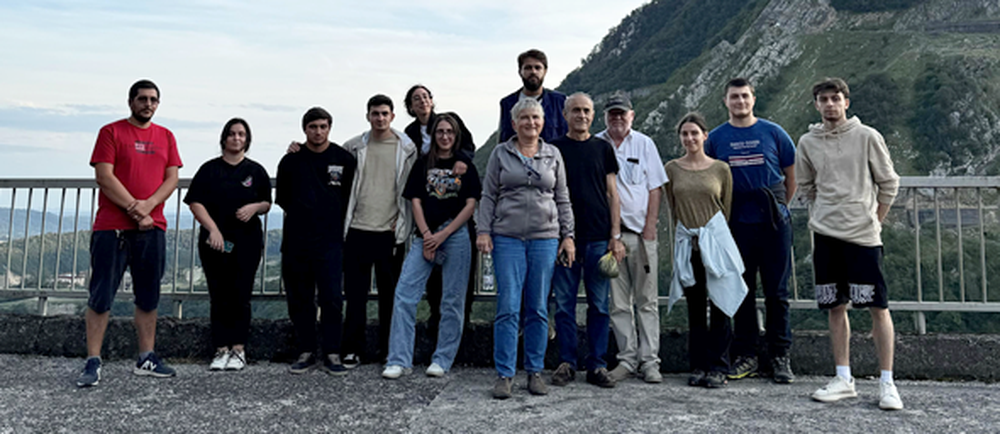
Friday, September 20, 2024
The day began with breakfast, after which Aleksandre Tepnadze assisted Mr. Thomas Röckel with core analysis. We continued the detailed examination of the cores, focusing on measurements and identifying fractures.
Later in the morning, we had a lecture led by Birgit Müller, which centered around tectonics. She discussed the differences between induced and natural earthquakes, how dams are connected to faults, and the potential risks this poses. Birgit also showed us a world map of earthquake activity, explaining which events were industrially induced and which were tectonic. Additionally, she highlighted the importance of understanding fault lines in relation to dam construction and safety.
After Birgit's lecture, Mr. Mirian Kalabegishvili presented on the functioning of hydro constructions, specifically focusing on the challenges of hydrosystem and hydraulic structure operations, such as dam tunnels, in Georgia. He also discussed how dams work within Georgia's hydroenergetic system, providing insights into the hydrosystems and various hydraulic structures, as well as the engineering challenges involved.
Once the lectures concluded, the students, along with the professors, went on a visit to see the Enguri Dam and the Core Archive, where all the core boxes from Enguri are stored. During this time, a few students, who had previously worked with me on core analysis, stayed behind to continue the independent analysis we had started earlier in the week.

When they returned from the dam visit, Mr. Thomas checked the measurements the students had made during the core analysis. He was pleasantly surprised to find that they made no mistakes and highlighted the well done analysis which was very encouraging.
Afterward, another lecture by Professor Birgit began, focusing on hydraulic fractures and pore pressure. She explained the concepts of maximum horizontal stress and minimum horizontal stress and how to measure them in a well. The main theme of the lecture was hydraulic fracturing, where she described the process of high-pressure injection of "fracking fluid" into the rock to create fractures, a technique used in the extraction of oil and gas. Birgit also demonstrated a hands-on experiment to show us exactly how hydraulic fracturing works. She used jelly, which was orange-colored and transparent, in a glass cup to represent rock. Using a straw and milk to simulate the fracking fluid, she inserted the straw into the jelly, creating a borehole. Slowly, she injected the milk into the jelly, blowing gently to simulate the injection process. Through this experiment, we were able to observe the basic principles of hydraulic fracturing in a visible, simplified form. This was fun for the students and the experiment definitely will be remembered whenever they hear again about hydraulic fracturing. And afterwards the jelly experiment was eaten by the students.
After the lecture, the students took some rest, and during their free time, Tornike and Aleksandrethen gave them the opportunity to apply the theoretical knowledge they had shared the previous day to practical work. They independently taught the hydrotechnics and construction students about key concepts like the reference line, the importance of distinguishing between natural fractures (NF) and induced fractures (IF), calcite veins, stylolites, and bedding planes. they also showed them how to measure parameters like UTP, LTP, Dip Direction, and Dip.
Afterwards, we let them try it themselves, using already analyzed cores to see if they could achieve the same results. To our surprise, they exceeded our expectations. We finished analyzing that corebox and began working on the next one. The students were eager to continue, so Aleksandre let them puzzle up the cores and draw the reference line themselves.
Saturday, September 21, 2024
Our last day at Enguri started with breakfast, followed by a lecture by Birgit Müller, which focused on the Gamma Ray Logging Tool. This tool is essential in geoscientific investigations, particularly in hydrocarbon exploration, and is used to measure the natural radioactivity in rock formations. The Gamma Ray Logging Tool detects and records the gamma radiation emitted by naturally occurring radioactive elements, such as potassium, uranium, and thorium, present in the rock layers. This data helps to distinguish between different types of rocks, particularly to identify shales (which contain more radioactive elements) from cleaner sandstones or carbonates. The tool is run down the borehole, and the recorded gamma radiation intensity provides a continuous log that correlates with different geological formations.
During the lecture, Birgit explained how this data is used to understand the composition and structure of subsurface formations, which is especially helpful in identifying potential hydrocarbon reservoirs or other resources. The tool is also important in defining shale content and can be applied in the context of hydropower-related geomechanical studies, like those at the Enguri Dam.
To engage the students further, Birgit selected one student and gave them a “Gamma Scout” device to measure the radioactivity of rocks. The rocks used for the demonstration were brought by Giorgi Mindiashvili, a PhD student and also lecturer (assistant to a professor) from the GTU Museum of ore deposits. Several students participated in the hands-on experiment, learning how to measure radioactivity in geological samples.
After the lecture, we had a short break to pack our bags and get ready for departure. Then, we gathered for lunch, after which Birgit presented us with certificates as a confirmation of our participation in the course. The certificate stated:
Headline: Confirmation of Attendance
[Name and Last Name] has successfully participated in the DAAD-SDG Caucasus course on Geomechanics with a focus on Drill Core Analysis.
Course contents: SDGs & Geomechanics, Enguri Geology & Tectonics, Induced Seismicity and Hydropower, the Gamma Ray Logging Tool, Numerical Modelling of Enguri High Dam.


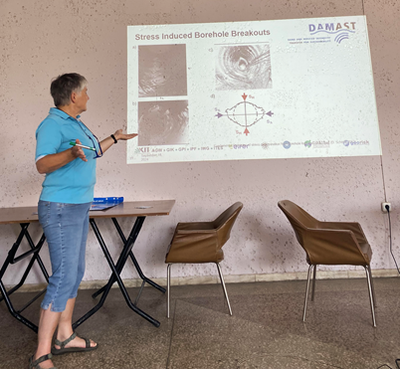
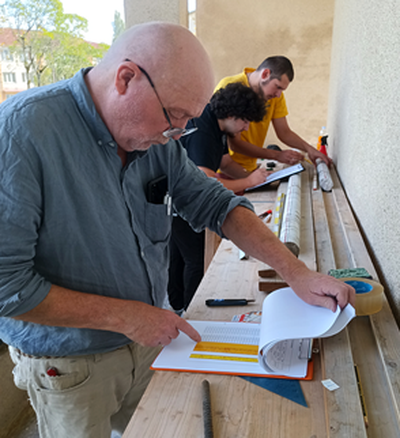
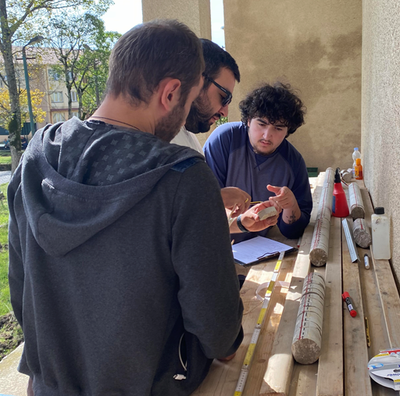
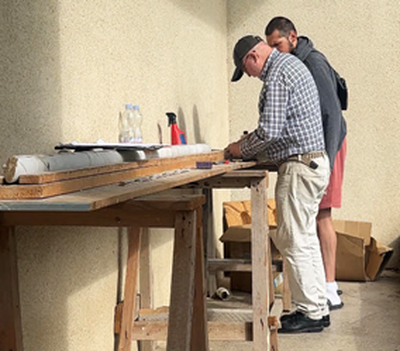
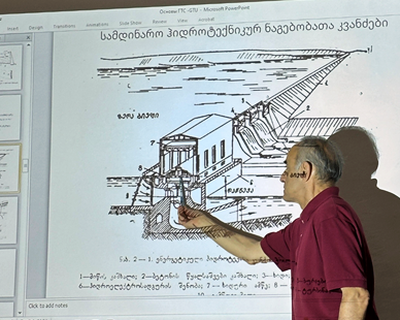
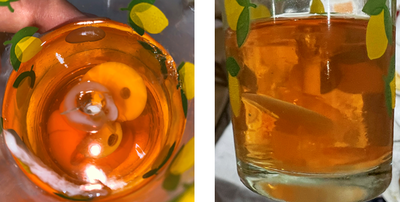
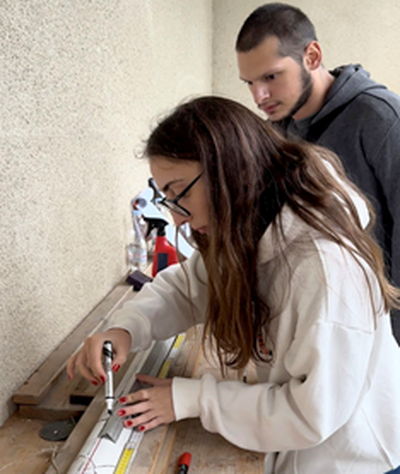
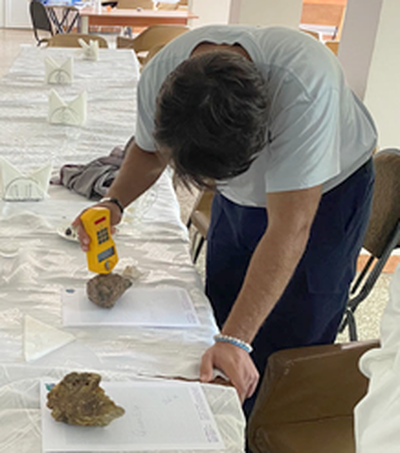
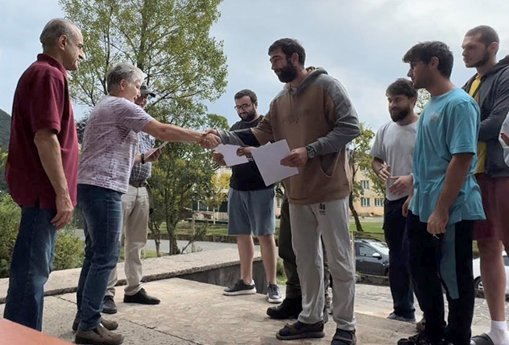
Conclusion
The DAAD-SDG Course on Geomechanics and Core Analysis at Enguri Dam provided an invaluable hands-on experience for all participants. Over the course of five days, we were able to blend theoretical knowledge with practical application, gaining a deeper understanding of both geomechanical principles and their relevance to sustainable development goals (SDGs).
From core analysis techniques and acoustic televiewer data interpretation to learning about hydraulic fracturing and fault systems in relation to dams, each lecture and practical exercise expanded our knowledge significantly. The involvement of both geoscience and construction students enriched the learning experience, fostering interdisciplinary collaboration.
The course emphasized the importance of precise measurement and analysis, particularly in the context of hydroelectric infrastructure like the Enguri High Dam. With the guidance of our dedicated professors, we were able to improve our skills and confidence in analyzing drill cores, interpreting data in WellCAD, and understanding the practical implications of geological features such as fractures, calcite veins, and stylolites.
The support and trust placed in us by the professors, especially Dr. Birgit Müller, allowed us to take ownership of the learning process, both in our group work and individual tasks. The lectures on tectonics, hydroconstructions, and hydraulic fracturing, alongside practical demonstrations, highlighted the complexity and interconnectedness of geomechanics, dam safety, and sustainability.
This experience not only strengthened our technical abilities but also deepened our appreciation for the broader implications of geomechanics in addressing global challenges such as clean energy, water resource management, and climate action. The course has been a stepping stone toward furthering our professional development in geology, and we are grateful for the opportunity to participate.
I want to extend my heartfelt thanks to DAAD, DAMAST, KIT, and all the organizations involved. A special and biggest thanks go to the professors, especially Birgit Müller, who has worked tirelessly to improve our knowledge. Her effort, trust, and dedication inspire me to do my best to meet her expectations.
Aleksandre Tepnadze
Addition of B. Müller: we lecturers had been very pleased by the students of the course and hope that this young generation will help Georgia to ensure its power production by hydropower. And that the two students Aleksandre and Lasha volunteered (really it was their suggestion) to write the report is great. Thank you so much.
Birgit Müller
Geomechanics Course with Focus on Drill Core Analysis
September 17-21, 2024 at Enguri Dam (Hotel Enguri)
This interdispicplinary course includes topics of borehole logging, structural geology, rock mechanics with a focus of drill core analysis. As practical issue the course considers core orientations at the example oft he Gia 1 and Gia 2 wells at Enguri High Dam in Georgia.
Lecturers: Birgit Müller (KIT), Thomas Röckel (Piewak & Partner), Gia Kalabegishvili
Course Outline and Schedule
September 17, Tuesday
| Evening |
Arrival of Students, Mini-presentation by students about their research |
September 18, Wednesday
| Morning | Pick Drill Cores at Warehouse+ Visit of Gia 1 drill site |
|
Lecture: Introduction to the Courses |
|
| Afternoon | Core Analysis/completing lists of analysed structures |
| Evening |
Lecture: Logging Tool Gamma -Ray |
September 19, Thursday
| Morning | Core Analysis |
| Afternoon | Core Analysis |
| Late Afternoon | Presentation Leonie Rossmanith (KIT-IMB): Numerical Modelling of Enguri Dam |
| Evening | Completing lists of analysed structures |
September 20, Friday
| Morning | Core Analysis , completing lists of analysed structures |
| Afternoon |
Core Analysis & Bringing back analysed core boxes to warehouse, / completing lists of analysed structures |
| Evening |
Lecture: Hydraulic Fracturing as a method to determine minimum tectonic stress |
September 21, Saturday
| Morning | Core Analysis |
| Later Afternoon |
Departure of Students |
Geothermal Field Trip in Georgia
The Grouting Workshop
Started at the beautiful location of Georgian Technical University
Students of Grouting Workshop participate in the field trip to the Mtkvari Hesi
They had been visiting the construction tunnels on the side of the power house and got explanations about the grouting of the lining. After a long bus ride they also visited the intake area of the Reservoir and could walk on the grout curtain. Special thanks to Director Mebonia and Gia Kalabegishvili as well to the team of Mktvari who enabled this visit.
Expert Bernd Aberle showed students not only theoretically the grouting, instead he provided lots of hands-on experiments and all students had been very concentrated in their works.
One of the days was devoted to a field trip to the Mtkvari HPP site which had been under contruction. Here had a wonderful tour through the pressure tunnel but also the outside installations.


